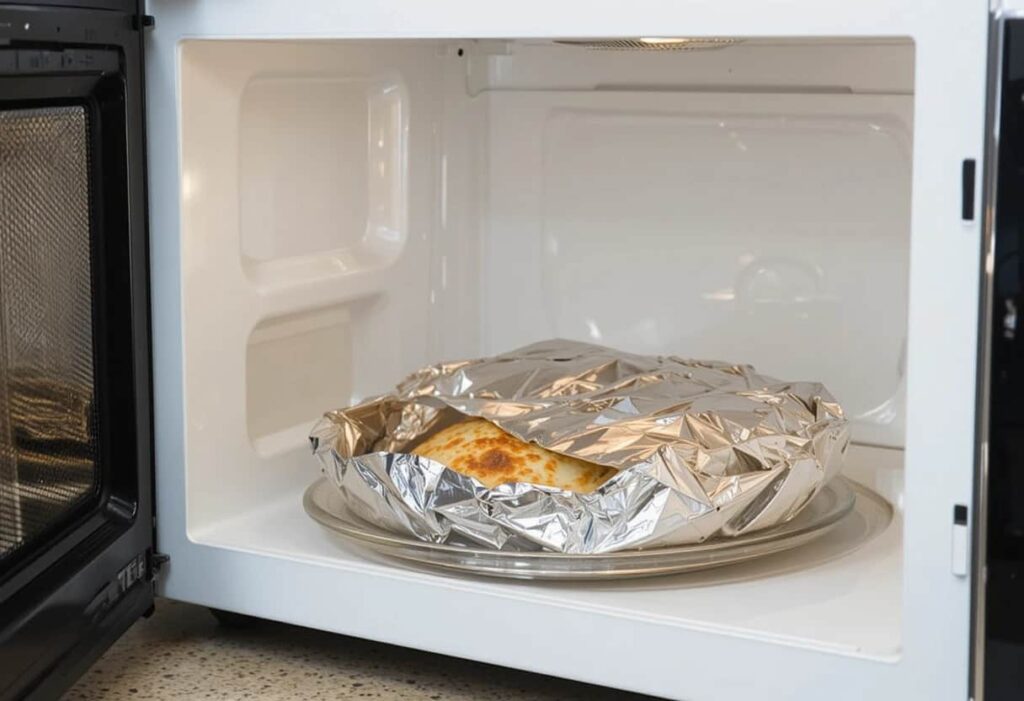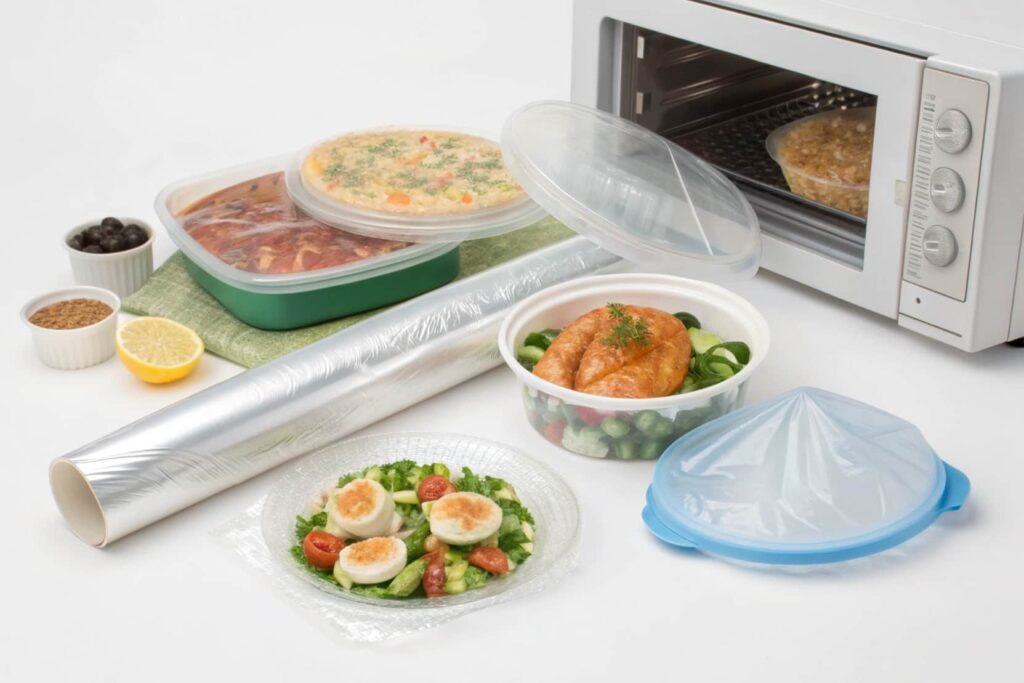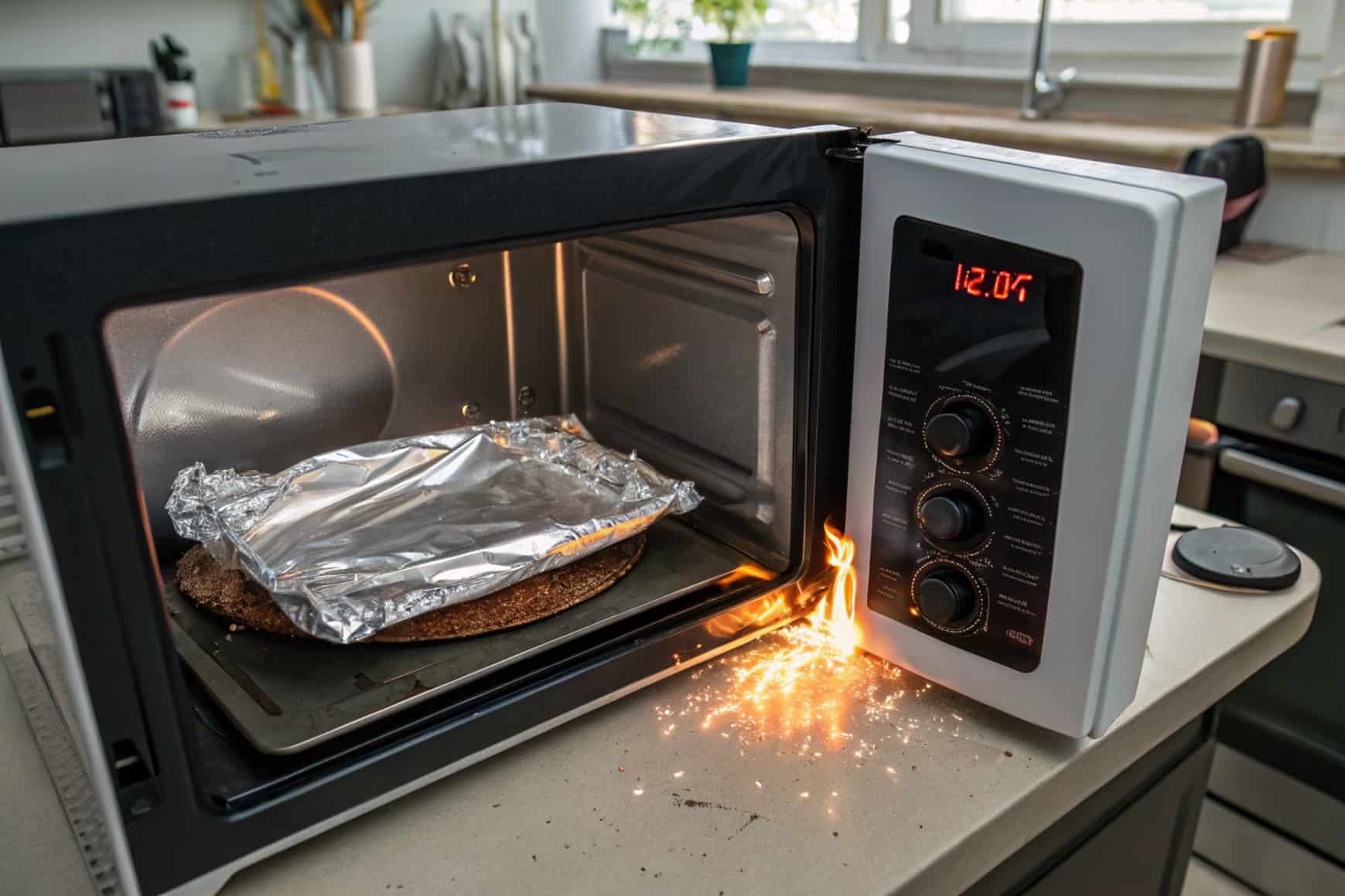Microwave ovens are one of the best inventions of modern life. Whether you want to heat up leftovers, defrost meat, or make popcorn, everything becomes easy. But one day, I made a mistake — I put aluminium foil in the microwave without knowing the rules. What happened next taught me a lesson I’ll never forget.
In this article, I’ll share my personal story, explain how aluminium foil reacts in the microwave, and give you safe tips to use it properly. If you’re confused or worried about using aluminium foil in your microwave, this article is for you.
I wish someone had warned me earlier, but sometimes we learn only after facing the consequences. That small mistake not only scared me but also made me curious about how microwaves work. Now, I feel responsible to share this knowledge so others don’t repeat the same mistake.
Can You Put Aluminum Foil in the Microwave?
Under the right conditions and with proper care, it is possible to use aluminum foil in the microwave. However, it must be done very carefully to avoid safety risks like sparks or fire. This guide will help explain how to use aluminum foil safely and what materials are best for microwave use.
Many people believe aluminum foil is always dangerous in microwaves, but that’s not entirely true. The key is knowing how to use it correctly and following your microwave’s manual. Used the wrong way, aluminum foil can damage your appliance or cause a fire.
If you’ve ever wondered, “can I put aluminium foil in the microwave?” — the answer is yes, but only in small amounts and under strict precautions. Make sure the foil is smooth and not crumpled, and never let it touch the sides of the microwave.
What went wrong when I put aluminium foil in the microwave?

A few months ago, I was heating some leftover chicken that was wrapped in aluminium foil. I was in a hurry and didn’t think twice. I just put the plate in the microwave and pressed “Start.” Within seconds, I saw sparks flying inside the microwave. I quickly turned it off.
My heart was racing. I opened the door and checked the foil — it had black marks, and the edges were burned. I thought I had broken the microwave. Luckily, nothing serious happened. But it could have been worse. That day, I promised myself I’d learn more about using aluminium foil in the microwave — and now I’m sharing what I’ve learned with you.
Why Aluminium Foil Sparks in the Microwave?
Aluminium foil sparks in the microwave because it reacts differently to electromagnetic waves. Microwaves heat food by targeting water molecules, but metal objects like aluminium foil reflect these waves instead of absorbing them. When foil is placed inside the microwave, the waves bounce off its surface, causing energy to build up.
If the foil is crumpled or has sharp edges, it can create electric sparks, known as arcing. This not only damages the food and microwave but can also become a serious fire hazard. Even a small piece of loose foil can act like an antenna and trigger sparks. Many people don’t realize this risk until they see it happen firsthand. That’s why it’s so important to understand can you put aluminium foil in the microwave safely before trying it.
What Materials Are Safe for the Microwave?
It’s safest to use items that absorb microwave energy properly. These include:
Glass and Ceramic:
- Most mugs, plates, bowls, and baking dishes are microwave safe.
- Avoid using crystal or handmade pottery unless labeled microwave-safe.
Some Plastics:
- Use only microwave-safe plastics. Look for labels.
- Avoid single-use plastics like yogurt cups or takeout containers.
Paper Products:
- Paper plates are usually safe unless coated with plastic.
- Paper towels can be used to prevent splatter. Avoid printed ones if unsure.
Environmental and Health Considerations:
Sustainability:
While aluminium foil is recyclable, its production requires significant energy and resources. Mining and refining bauxite ore creates environmental impacts. For eco-friendly alternatives, try reusable silicone lids or beeswax wraps. When you do use foil, always recycle it properly after use.
Also: Above Range Microwave Stainless Steel – A Practical Kitchen Upgrade!
Health Risks:
Small amounts of aluminum leaching from foil pose minimal risk for most people. However, those with kidney disease should limit exposure as their bodies can’t filter aluminum effectively. While occasional use is safe, avoid cooking acidic foods in foil. For daily needs, glass or ceramic containers are healthier alternatives that eliminate any metal transfer concerns.
Safety Rules for Using Aluminium Foil in the Microwave:

Keep It Flat and Smooth:
Microwaving wrinkled aluminium foil creates dangerous electrical sparks that can damage your appliance or start fires. Always completely flatten foil before use, removing all creases. Discard any foil with existing bends, folds, or tears. Perfectly smooth foil distributes heat safely without arcing. This simple step prevents 90% of microwave foil accidents. Remember: flat foil is safe foil when microwaving foods.
Use Minimal Coverage:
Limit foil coverage to just 25% of your food’s surface area. Excessive foil blocks microwave energy, creating unevenly heated cold spots. For sandwiches, cover only the crust edges to prevent sogginess while allowing the center to heat. The majority of food should remain uncovered for proper cooking. Smaller foil pieces work more effectively than large sheets for even heating results.
Maintain a 1-Inch Gap:
Always position foil at least 1 inch from microwave walls, ceiling, and turntable. This buffer zone prevents wave reflection that causes sparking. Use appropriately sized dishes to maintain this crucial spacing. In compact microwaves, it’s safest to avoid foil altogether. Proper spacing eliminates electrical arcing risks that could potentially start dangerous microwave fires.
Avoid Metal Turntables:
Metal surfaces dangerously amplify foil’s reflective properties in microwaves. Always place foil-wrapped items on microwave-safe glass, ceramic, or approved plastic plates. Carefully inspect your microwave for concealed metal components that might interact with foil. The combination of metal surfaces and foil significantly increases sparking and fire hazards during operation.
Never Reuse Old Foil:
Previously used foil develops microscopic weak points invisible to the eye. These compromised areas overheat rapidly, creating potential spark points. Always use fresh, pristine foil sheets for microwave applications. While environmentally conscious recycling is important, never compromise microwave safety by reusing foil. New foil guarantees consistent, safe heating performance every time.
Skip Aluminium Containers:
Solid aluminum cookware completely blocks microwave penetration, preventing proper food heating. These thick metal containers may also damage microwave components. Always transfer food to microwave-approved glass, ceramic, or plastic dishes before heating. Reserve aluminum bakeware for conventional oven use only, where metal behaves predictably and safely during cooking processes.
Monitor Constantly:
Never leave foil-containing microwaves unattended, as sparks can ignite in seconds. Stay within immediate view of the appliance throughout the heating process. At the first sign of sparking, immediately stop the microwave. Exercise caution when opening afterward, as trapped steam can cause burns. Constant vigilance is the key to preventing foil-related microwave accidents and ensuring safe operation.
Also read: Jiangsu Zdecl Microwave Technology Co.Ltd – Leading Microwave Tech Today!
Is It Safe to Put Aluminum Foil in the Microwave?
Can I put aluminium foil in the microwave? Yes — but only with extreme caution. Follow your microwave’s manual. Even when it’s allowed, use only small, flat pieces and never let it touch the microwave walls.
Why Use Aluminum Foil in the Microwave?
Some people use aluminum foil to:
- Cover food and stop splattering
- Keep heat in
- Help steam cook food
When used correctly, the foil can help. But it must be used carefully and flat.
How Microwaves Work?
Microwaves heat food using electromagnetic waves. These waves move through food and generate heat. Can aluminium foil go in the microwave without affecting this process? Only if it’s used properly.
- Leave your food undercooked
- Damage your microwave
- Even cause sparks or fires
When to Avoid Aluminium Foil Entirely?
Acidic or Salty Foods:
Avoid foil with acidic foods like tomatoes, citrus, or vinegar-based dishes. The acid reacts with aluminum, causing metal to leach into your food. This can alter taste and pose health concerns with frequent use. For these foods, use microwave-safe glass or ceramic covers instead. Better safe than sorry when dealing with chemical reactions in your microwave.
High-Fat Foods:
Greasy foods like bacon or fried items are risky with foil. The fat heats unevenly, causing dangerous splattering and potential arcing. These splatters can ignite under intense heat. For fatty foods, use paper towels or microwave-safe lids to contain splashes. They absorb grease without the fire hazard that foil presents.
Pre-Packaged Meals:
Some frozen meals contain microwave-safe foil layers (like certain pizzas). Always verify packaging instructions first. If unsure, transfer food to a microwave-safe dish. The foil in pre-packaged meals is specially designed – your regular household foil isn’t equivalent. When in doubt, take it out (of the foil, that is).
Also read: Maury Microwave – Top Products, Features & Industry Uses Explained!
Can You Use Aluminium Foil in the Microwave at All?
Yes, but only in very specific conditions. Most people think aluminium foil is completely banned in microwaves, but that’s not true. The key is to use it safely and correctly. You can use small pieces of foil to cover parts of food that might overcook, like the tips of chicken wings or the edges of a pie crust.
The foil must be flat and pressed tightly against the food — no sharp edges or pieces sticking out. Never let the foil touch the sides of the microwave, as this can cause sparks. Always read your microwave’s manual to check if foil use is allowed. Also, avoid using foil with foods that have metal twist ties or clamps, as these can increase the risk of arcing. Using aluminium foil safely requires attention and care, but it can be helpful when done properly.
Can You Put Metal in the Microwave?
In most cases, you should not put metal in the microwave. Metal reflects the microwave energy, which can lead to sparks and even damage your microwave.
What Metals to Avoid?
You should avoid using:
- Steel
- Iron
- Copper
- Aluminum bowls or trays
These can all cause problems in a regular microwave.
Can You Put Aluminium Foil Containers in the Microwave?
Yes, you can put aluminium foil containers in the microwave, but it must be done very carefully. Aluminium is a type of metal, and metal can cause sparks or fire in the microwave if not used the right way. However, with proper instructions and caution, using aluminium containers is sometimes safe in modern microwaves.
When It Is Safe to Use Aluminium Foil Containers:
- When the container is small and does not touch the microwave’s walls or door.
- When the food inside fully covers the bottom of the container.
- When the foil lid or any cover is removed before heating.
- When you use lower power settings like “defrost” or “medium heat”.
- When your microwave’s instruction manual allows using aluminium containers.
When It Is Not Safe:
- When the container touches the sides or roof of the microwave.
- When the foil is wrinkled or has sharp edges, which can cause sparks.
- When the container is empty or almost empty.
- When too much foil is used, as it can block the heat from spreading evenly.
Possible Dangers of Incorrect Use:
If aluminium foil containers are used the wrong way, it can result in:
- Sparks or popping sounds inside the microwave
- Uneven heating or cold spots in your food
- Damage to the microwave’s parts
- Risk of a fire starting inside the microwave
Safety Tips for Use:
- Always check your microwave’s manual before using any metal container.
- Heat food only in small portions and watch carefully while heating.
- Place the container on a microwave-safe glass or ceramic plate to keep it stable.
- Avoid using containers that have folded, sharp, or damaged edges.
Alternatives to Aluminium Foil in the Microwave:
If you want to avoid the risks of using aluminium foil, there are safer alternatives. Parchment paper is heat-resistant and safe for microwaving, while microwave-safe plastic wrap is great for steaming food. Glass or ceramic covers are reusable and provide an effective seal.

For added convenience, microwave-safe lids are specially designed to prevent splattering, ensuring your food heats evenly and safely. You can also use silicone covers, which are flexible and durable, offering a great alternative to foil. Additionally, consider microwave-safe cookware made from materials like tempered glass, which can handle high temperatures without any risk of sparks or fire.
FAQS:
1. Can I use aluminium foil to cook in the microwave?
Aluminium foil can be used in the microwave for specific purposes, like shielding parts of food to prevent overcooking. However, it must be used carefully. Ensure it is smooth, small in size, and not touching the microwave walls. Never completely cover food with foil or leave loose edges exposed.
2. Why can’t I cover my entire dish with aluminium foil in the microwave?
Covering an entire dish with foil blocks microwaves from penetrating the food, preventing even cooking. It also increases the risk of sparking or arcing. To safely use foil, cover only small areas of the food that need protection, such as the edges of meat or poultry.
3. What should I do if my microwave sparks when I use foil?
If your microwave sparks while using foil, immediately stop the microwave. Remove any metal objects, especially crumpled foil or items with sharp edges. Check the interior for any damage or metal touching the walls and ensure the foil is properly positioned.
4. Can I use aluminium foil in a microwave with convection mode?
Yes, aluminium foil can be used more freely in a microwave with a convection mode. Since convection mode works like a regular oven, the foil won’t cause the same problems as in a standard microwave. However, safety guidelines should still be followed, using small amounts and ensuring the foil is flat.
5. Is it safe to microwave food in a metal pan or tray with foil?
Microwaving food in metal pans or trays, even if they have foil, is generally not safe. Metal can cause arcing or sparking inside the microwave, which may damage the appliance or cause a fire. Instead, opt for microwave-safe glass, ceramic, or plastic containers for safe and even cooking.
Conclusion:
In conclusion, while it is possible to use aluminum foil in the microwave under specific conditions, safety precautions must always be followed. Ensure that the foil is smooth, flat, and used sparingly to avoid sparks or fire hazards. Alternatives like parchment paper or microwave-safe covers offer safer options for heating and cooking food in the microwave.
Always prioritize safety and be mindful of the risks when using metal in such appliances. Additionally, it’s important to check the manufacturer’s instructions to ensure compatibility with aluminum foil. If in doubt, avoid using metal altogether to prevent accidents. By following these guidelines, you can safely use the microwave for various cooking tasks.
Related post:
- Ge Microwave Jkp86sof2ssmodel – Specs, Pros, And Honest Opinion!
- Perfect Vegetables Microwave Bags By Terinex – Healthy, Fast & No Mess!
- Over-The-Range Ge Microwave Model Jkp86sof255 – Must-Know Benefits Before You Buy!
